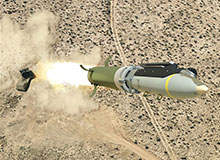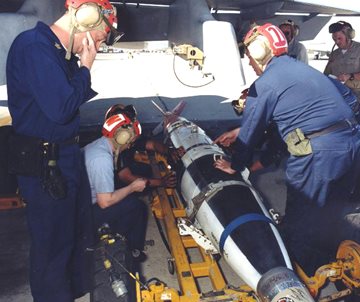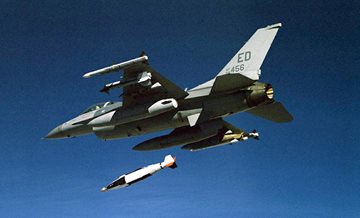Yes it is and I've just sent a copy of my most recent chapter off for a review so I've got a day or two to kill.
I like these little forays into the ether so here's mine on what needs to be done.
I'll start off with a big assumption that one actually wants to make a more effective and capable army than the one we have now. An army's effectiveness depends on both people and equipment. We have both in varying states. The question is how to make them better.
Thread 1 - People.
People are an expensive annually recurring cost. Especially full time ones. Barring a major incident or a Come to Jesus moment in the government, we're not getting anymore.
Does the army need more people? Based on discussions in these forums - you betcha - especially in field units, CSS and possibly CS and schools. Where do we get them? Barring a Come to Jesus moment amongst the CAF leadership, they sure as hell aren't coming out of the NDHQ structure which basically leaves superfluous organizations or C2 overhead. Conclusion - a restructuring is needed.
Stipulated without reservation.
Thread 1 A - People restructuring.
When we look at the organizations which the army really, desperately needs, we need to have an understanding of the missions it needs to perform. SSE is very broad, and while asking for the world, says we only need to cover it in little drabs here and there. The direct requirement is for forces at a battle group level. There is an indirect requirement of some vague capability for peer-to-peer high intensity conflict.
Again, stipulated
It is frankly silly and dangerous to conclude that a battle group commitment is all that the army will ever have to commit to a peer-to-peer high intensity conflict. Something bigger may very well be called on and the army should prepare for that eventuality. First Conclusion - a people restructure should be based on a day-to-day requirement to provide battle-group sized elements (which could also include a brigade headquarters) on a continuous, sustainable basis. Second Conclusion - the force must be able to grow into something bigger than a battle group for short durations (the definition of short may be vague but let's say less than three years)
I agree with your day-to-day assertion.
With respect to expansion: It may be dangerous but it is not a scenario which our governments wish to address. Consequently they will not fund it until their noses are shoved in it and bleeding. The only MUST we can afford is a plan to do something in the future with the tools that the future may or may not provide. We can't afford to buy kit today that may not be useful when and if.
Thread 1 B - Day-to-day v Expansion
Since people costs is our greatest limiting factor it is inescapable that day-to-day needs, for the most part, require a full-time force that can be counted on and sufficiently trained to fulfill all day-to-day missions. The army currently has twelve full-time manoeuvre units that can be the foundation of battle groups. It has three brigade headquarters that can act as a lead nation element. At the rate of two simultaneous sustained ones (plus others) sustained operations for six months per rotation could involve the deployment of four or more battle groups per year. First Conclusion - there are barely enough full-time battle groups to sustain operational requirements without degrading training and personnel development. Second Conclusion - missions need to be reduced or more battle groups and brigade headquarters need to be formed.
I would argue we do not, indeed have 12 full-time manoeuvre units. We have 12 full-time manoeuvre unit headquarters which, like their brigades, division and joint force are looking for something to do and something to do it with. To say they are shadows does disservice to the shades.
Having said that I agree with both your conclusions. I would not be a fan of increasing the number of HQs.
Traditionally, and practically, surging capabilities when needed can best be accomplished by a trained and capable reserve force. By all measures and standards, the army's reserve component is neither trained nor capable - a situation that has been recognized, without correction, for decades. While reserve units can provide individual augmentees and even platoon sized elements from time-to-time, they are incapable of providing even company strength elements much less battle group or brigade headquarters ones for sustained operations or for an expansion of the force beyond its day-to-day requirements. Third Conclusion - a fundamental restructuring and repurposing and training model of the reserve force is a sine quo non to any meaningful reform of the army's personnel issues.
I too am a Reserve Force fan. And I wish that Canada had one. Some hope. 40 years on and the signs continue to be discouraging. Inadvisable as a viable course of action.
Lastly, it is debatable and possibly highly unlikely that at the scale needed, that the reserve force can develop the leadership or organizational structure to be able to form deployable battle-groups or brigade headquarters in its own right. Fourth Conclusion - that a fundamental restructuring and repurposing of the reserve force will require a full-time leadership and staff in many key positions.
Agreed but see above.
While there are numerous options which can be pursued, the most likely capable of meeting the dual roles of added rotations on day-to-day missions and extraordinary force expansion involves a hybrid reserve force with substantial full-time personnel at battle group and brigade headquarters. This can undoubtedly not be provided at the rate of the ten existing brigade headquarters and 130 some odd units. Fifth Conclusion - that while the manpower of the reserve force be maintained, the number of formations and units be dramatically reduced to conform to the current manpower levels.
Disagree on the Hybrid Solution. The Hybrid Solution does not generate a ready force. The ready force can only be generated by full-time soldiers in barracks, twiddling their thumbs if need be. The challenge is to keep them occupied and the best solution is spending money on constant training on useful kit.
Agree that if the Reserve Force is to be retained then it should be reorganized appropriately into useful elements.
Thread 2 - Equipment
Like people, equipment is expensive both for acquisition and for ongoing maintenance.
Thus Wooden Rounds and "Green Goddesses" - The Green Goddesses were, simple, utilitarian vehicles that sat idle for most of their lives but enough of them sparked over, even with Lucas Electrics, when needed that they were useful. They could even be driven and manned by the infantry in a civil emergency.
Currently there is sufficient equipment for approximately six mechanized infantry battle groups equipped with LAVs, one armoured battle group with tanks, two mechanized reconnaissance battle groups and three light infantry battle groups.
Agreed, kind of. Except for logistics, air defence, anti armour, DFS, EW and some other kit that comes in handy.
From a CS perspective there is sufficient artillery to equip one towed artillery regiment, three combat engineer regiments and one engineer support regiment as well as several other diverse capabilities.
Agreed
There is roughly sufficient equipment to equip three logistics close support battalions and enough headquarters and signals equipment for three brigade group headquarters and a divisional headquarters.
Is there?
There are many deficiencies in specific CS and CSS enabler categories.
Agreed
First Conclusion - there is enough equipment to outfit up to a one-time weak division or three separate brigades but with limitations. Second Conclusion - there is very limited provision for replacement of equipment from combat losses other than from the stocks of other units/brigades.
Agreed and agreed.
Acquisition of equipment, including ammunition, is a long term process.
But is doesn't have to. That is a policy and bureaucracy issue more than anything else. It isn't even, really a budget issue. We choose to hire people for headquarters than buy bullets for ranges.
While rapid acquisition is possible through a UOR process during routine day-to-day operations, it is unlikely that any such rapid acquisition will be possible for an expansion of the force during an emergency as most probably all such equipment will go as a first priority to the manufacturing nation's own military
Agreed, so we will have to work with what we have. From our own factories and our own warehouses. Which we should be filling with regular rotation of stock to the ranges.
. Second Conclusion - If the force is restructured, additional equipment for it will take a considerable time to be available.
Agreed
As a result any restructure must in its first phase relay massively on shared equipment usage. Third Conclusion - if there is an intention to expand the force in times of emergency then a deliberate plan must be developed to determine the size and purpose of the expanded force and to initiate a priorized equipment acquisition and maintenance program.
I would be happy to see the available, regular, day-to-day force fully equipped and exercised for the missions they will routinely encounter. Let's worry about fleshing out the Regular "Division-Light" before we start rebuilding the Canadian Corps.
Thread 2 A - Equipment Composition/Force Structure
Our three full-time brigades are structured as both a light and medium force with some heavy components in part to assist the brigade-level managed readiness cycles. This complicates both maintenance and training. Respectfully, this priorizes an administrative requirement over operational ones. Both maintenance and training would be enhanced if equipment and units within a given brigade were organized to a common purpose. First Conclusion - the most logical is to reorganize into a light brigade and two medium brigade, one of which is augmented with tanks.
That's good. Although I would offer that the tanks should not be part of the brigade structure but they and the armoured engineer squadron should be an independent entity, directly subordinate to the division or in the CCSB. They should be co-located with one of the Medium brigades. The rationale is that the tanks don't move at the same rates as the LAVs. Operationally they are slower, tactically they may be faster. And they need their own specialized support system to include Tank Transporters.
Since equipment will not be acquired for the hybrid/reserve force in the first phase and equipment will need to be shared, then the hybrid/reserve force structure must mimic the restructured full-time force one to the extent possible within manpower limitations. Second Conclusion - the hybrid reserve force should be restructured into a light and two medium manoeuvre brigades as well as a CS brigade and CSS brigade (or two) that complement the full-time CS and CSS structures.
Disregard the brigade structure for the reserve force and structure as independent sub-units that can be attached to the regular force, or be used as replacements.
The lack of equipment to expand on makes it impossible to determine the expanded force structure. This is a feature rather than a defect. It allows the government and the CAF to properly analyze where it wants to be ten years out from today to be able to meet the probable future threats. This is a risk assessment. While it is an arguable point, all indications are that the best return on investment is the structuring of a force that will be a credible force to assist our allies to deter large power expansion while retaining the ability to meet minor crises and conflicts. Third Conclusion - based chiefly on the size of manpower for the army (both full and part-time) that the government is prepared to invest in it would be logical to aim at developing for phase 2 a fully equipped division with sufficient additional equipment for one or two brigades to make up for combat losses and permit secondary deployments away from the main force.
If we are dollar rich, and manpower deficient is the army, an army that will be deployed on voluntary missions to support allies at the discretion of the government of the day, a government that is notably averse to spending both dollars and manpower, the best method available to us to support our allies? Or should we concentrate on air assets, or maritime assets and limit our ground forces? Are they ever going to be used in a war of national defence? I keep being told that nobody wants Canada therefore will never invade and therefore there is no need to supply ground forces to counter them. Is an expeditionary army actually a vanity project? Why not send an expeditionary air force instead?
Thread 2 B - Fires
Fires play a minor role in day-to-day peacetime operations other than ones specifically targeted at deterrence such as in Latvia and to an extent in the Ukraine. For routine day-to-day operations the peacetime force relies more and full-time light rapid response forces and as such the fires component should complement that.
Agreed
Accordingly, our current M777 fleet is adequate for that purpose.
Disagreed
Why then the deployment by our allies of the 70 km Sniper, instead of its cousin the Grid Square Removal System? Why the purchase of the NLOS Spike for 25 km PGM role? The purchase of more RPAS systems of various sizes which are capable of Loitering overhead while providing surveillance, recce and precision strike?
The M777 is still an area weapon, which is not suitable for peace-keeping, and which ties up an inordinate number of gunners. Your regiment was equipped to deploy three regiment of 18 guns, 24 at one time.
Other requirements came your way and you had to start bleeding gun numbers to man the guns. You started off with a 105 section of 7 gunners manning each M777 that you determined actually needed 10. You didn't have gunners available to man the 105 sections, along with the 81mms, the FOOs, FACS, FSCCs, the STA asssets and the UAS systems. So you cut the number of guns. And you eliminated anything that looked like air defence. Because you didn't have enough gunners.
You couldn't find 180 gunners in a regiment to man 18x M777 155s. You couldn't even find the 126 gunners necessary to man the M777s like LG1s or C3s. So you cut the battery down to 4 guns manned by 28 gunners and went begging for more gunners.
Meanwhile you could have manned 6x Archer-155s with 18 of those 28 gunners and had 10 left over for an Air Defence Section. And you would have had the benefit of better navigation, less requirement for recce, and less vulnerability due to the ability to shoot and scoot.
And as for ammunition. You have already declared that in peace-keeping the issue not weight of fire. A large ammo train is not key to success.
Quick question: Which would you rather have an armoured squadron with 19 Leos, or an armoured squadron of 14 Leos backed by Six-tube SPH battery and a CAMM-ER AD troop delivered in the 5 C17 flights saved by reducing the size of the Leo squadron to a number commonly found in allied armies?
The M777 fleet, however, is not adequate for more intense operations and additional system for that, as well as for day-to-day operations should be examined and planned. All brigades and battle groups need readily available, if not organic, fire support coordination and observer detachments.
Agreed
First Conclusion - the M777 fleet should be combined with the light brigade group with an equal ratio of full-time and part time detachments. Second Conclusion - observer batteries should remain as collocated with manoeuvre battle groups and brigades as possible regardless of the location of the fires batteries. Third Conclusion - other than M777 fires units can have a high ratio of reservists. Fourth Conclusion - a coordinated and funded project for establishing a credible and effective fires capability is critically required.
I would put all the M777s, bar one battery, into the Reserve Force and keep one battery on stand by with either Regs or committed Class B/C reservists.
Agreed entirely on the observation and co-ordination.
Agreed on the utility of the Reservists in Artillery, in all types of firing batteries, including Air Defence. My concern is I don't expect to see the government spending the money. Not so long as guns are perceived as killers and not as necessary tools for protecting deployed Canadians and Allies abroad, and citizens at home.
Agreed on the need. My expectations are low.
Not that other than fires, I can't help myself, I've shied very far away from the issue of the types of equipment and even the structure of a battalion or brigade that we might want for phase two concentrating instead on the size of the pool. Obviously the decision of the equipment is completely and utterly dependent on the objective of the force and there is much that needs to be looked at first. To me the composition of what constitutes a brigade or a battle group or a division in this discussion is still wide open. I'm only talking broad concepts here within rough manpower factors.
Seen
I tend to think that on the manoeuvre side I'd put all my effort into two heavy brigades (one full-time and one reserve/hybrid) even if they are only pseudo-heavy to start with for the reason that 1) we don't have any now, 2) we really need them if we're staying in NATO and 3) we have already have okay stuff for two light and two medium brigades (one each full-time and reserve/hybrid).
For fires we only need one brigade which basically means two more regiments worth of things that shoot (SPs), an AD regiment and a rocket/missile regiment not to mention loitering munitions capabilities (most of that reserve force)
I'm more inclined to create an independent Deep Strike type Brigade (Fires with ISTAR) that can be added to an allied brigade or even supply a Corps capability. I'd go with a couple of DSBs, with LR fires and the LAV battalions as ISR assets, your light brigade (but it needs more helicopters and probably swapping the C130s for the A400s, and a single Penetration Battle Group complete with a small number of compatible vehicles like the CV90s to carry a couple of companies of troops as Panzergrenadiers.
I won't touch on other CS and CSS other than to say it needs to fill the maximum effort capability.
Seen
For those of you who don't like my reference to a division all I can say is if the army is going to have over forty thousand folks in it (or over 20,000 full-timers) it should be aiming at a worst case scenario of a division while making it easier to operate continuous sustainable battle group deployments in peacetime. The two are not mutually incompatible.

I agree. It should. But this is Canada.
Cheers.









